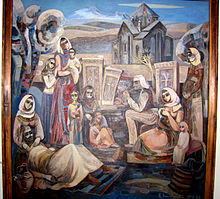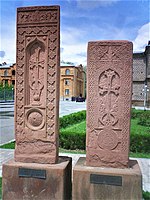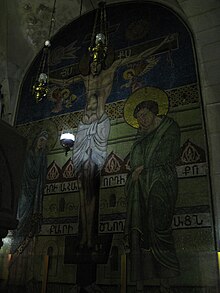| Part of a series on the |
| Culture of Armenia |
|---|
 |
| History |
| People |
| Languages |
| Traditions |
| Mythology |
| Cuisine |
| Festivals |
| Religion |
| Art |
| Literature |
| Music and performing arts |
| Media |
| Sport |
| Monuments |
| Symbols |


Armenian art is the unique form of art developed over the last five millennia in which the Armenian people lived on the Armenian Highland. Armenian architecture and miniature painting have dominated Armenian art and have shown consistent development over the centuries. Other forms of Armenian art include sculpture, fresco, mosaic, ceramic, metalwork, engraving, and textiles, especially Armenian carpets.
Prehistoric Armenia was home to the Urartu culture in the Iron Age, notable for its early metal sculptures, often of animals. The region was, as later, often contested by the large empires holding the nearby regions of Persia, Mesopotamia and Anatolia. The Armenians adopted Christianity very early, and developed their own version of Eastern Christian art, with much use of icons, Armenian miniatures in books, and the very original architecture of their churches and monasteries. A distinctive Armenian feature, which may have influenced the Medieval art of Europe, was the popularity from early on of figurative relief carvings on the outside of churches, unknown in Byzantium.
Armenians specialized in arts and crafts such as carpet-weaving.
Study of Armenian art history
The study of Armenian art began in the early 20th century. Notable scholars of Armenian art were Catholicos Garegin Hovsepian and professor Sirarpie Der Nerséssian. More recently, Jean-Michel Thierry and Professor Dickran Kouymjian are prominent scholars of Armenian art.
Architecture
Main article: Armenian architectureThe first Armenian churches were built during the lifetime of St. Gregory the Illuminator, were often built on the sites of destroyed pagan temples, and imitated some aspects of Armenian pre-Christian architecture.
Classical and Medieval Armenian architecture is divided into four separate periods.
The first period, from the 4th to the 7th centuries, began with Armenia's conversion to Christianity, and ended after the Arab invasions of Armenia. The early churches were mostly simple basilicas, some with side apses. By the 5th century the typical cupola cone in the center had become widely used. By the 7th century, centrally-planned churches had been built and the more complicated niched buttress and radiating Hrip'simé style had formed. By the time of the Arab invasions, most of what we now know as classical Armenian architecture had formed.
The second period lasted from the 9th to the 11th centuries. Armenian architecture underwent a revival under the patronage of the Bagratid dynasty with many buildings erected in the regions of Ani and Lake Van: these included both traditional styles and new innovations. Ornately carved Armenian khachkars were developed during this time. Many new cities and churches were built during this time, including a new capital at Lake Van and a Cathedral on Akdamar Island to match. The Cathedral of Ani was also completed during this dynasty. It was during this time that the first major monasteries, such as Haghpat and Haritchavank were founded. This period was ended by the Seljuk invasion.
Miniatures
Main article: Armenian illuminated manuscripts
Illuminated manuscripts were produced in Armenia mainly between the 5th and the 17th centuries. The highest point of this art is associated with the 13th century and the name of Toros Roslin, considered to be the most prominent medieval Armenian manuscript illuminator. The majority of the manuscripts were lost, and scholarly approach to studies of Armenian illuminated manuscripts was only developed in the second half of the 20th century.
Sculptures

Each culture possesses a certain original element which becomes a symbol of the entire national culture. In Armenia such symbol is “khachkar, the so-called cross-stones, the monuments of Armenia which are not found anywhere in the world. The word “khachkar” is formed by two Armenian roots: “khach” (cross) and "kar" (stone). Armenia has been called “a country of rocks” and has a rich heritage when it comes to sculptures. Some of the sculptures in the country date way back even before the formation of Armenia as a nation. Such sculptures were created by empires that existed in the region before the modern period. A good example of these is the “Khachkar” which were ancient religious sculptures. Besides these ancient sculptures, Armenia also has plenty of post-war sculptures which show the influence of modern times and also foreign traditions that have been adopted.
Frescoes, Mosaics, and Ceramics

Ceramics, mosaics, and frescoes constitute a different category of Armenian artwork. The creation of the outlined artifacts dates back to the days of the Urartian Empire that existed long before the establishment of Armenia as a nation. Therefore some of the ancient art is shared among several countries in the region that were part of the Urartian Empire. While the evidence of these forms of art was realized through excavations in the country, their remains have been reconstructed thus providing physical evidence of what they looked like.
Gallery
-
 Armenian Birds Mosaic in Jerusalem
Armenian Birds Mosaic in Jerusalem
-
 Wall paintings inside the Church of Akhtamar
Wall paintings inside the Church of Akhtamar
-
 Probable depictions of Shahnshah's wife Vaneni (left), her husband Shahnshah Zakarian (middle), and a kindred in military uniform (right), as donators at the Kobayr Monastery Chapel-Aisle
Probable depictions of Shahnshah's wife Vaneni (left), her husband Shahnshah Zakarian (middle), and a kindred in military uniform (right), as donators at the Kobayr Monastery Chapel-Aisle
-
 Mural representing Khutlubuga in the Church of the Holy Sign, Haghpat Monastery
Mural representing Khutlubuga in the Church of the Holy Sign, Haghpat Monastery
-
 Wall painting of Deesis in Haghpat Monastery
Wall painting of Deesis in Haghpat Monastery
-
 The murals of varios saints in Akhtala Monastery
The murals of varios saints in Akhtala Monastery
-
Fragment of a 13th-century fresco with Armenian inscribed text in Dadivank Monastery
Metalwork and Engravings

Armenia has a history of making engravings and metalwork which are also considered as part of the art. Artifacts in this category can be subdivided into coins, silver and gold, and bronze and tinned copper. The coins refer to the pieces of metals that were designed during the ancient times for trading purposes between Armenia and its neighbors such as Greece. On the other hand, gold and silver were luxury items during ancient Armenia which were fashioned in various ways such as drinking vessels, medallions, and statues just to mention a few. Besides, tinned copper and bronze were also used. Excavations in the country have revealed that these were used to make household items, weapons, and even statues.
Textiles
Main article: Armenian dressTextiles are another part of Armenian art and also a significant part of their economy both in the ancient and present times. One of the most extensive collections of Armenian textiles can be found in the Armenian Museum of America. In the current world, textile products from Armenia are a major trade commodity between Armenia, Europe, and America.
Armenian carpets
Main article: Armenian carpet Main article: Karabakh carpetMusic and dance
Main article: Music of Armenia Main article: Armenian danceDance and Music are also an essential aspect of the Armenian Heritage. Initially, Armenian music consisted of Armenian Church music and folk songs that were based on an indigenous tonal system (Tetrachords) as opposed to the European tonal system. However, in the present time, other genres of music have influenced Armenian music thus resulting in the production of modern styles in the country such as Hip Hop, Pop, Rock, among many others. Accompanying original Armenian songs was Armenian dance. Native Armenian dance is one of the oldest practices of the inhabitants of the region. Armenian dance is even depicted in some of the ancient paintings on rocks.
Modern art
Modernist art
Famous Armenian modernist artists include painters like Arshile Gorky and Paul Guiragossian.
Contemporary art
In 2015, Armenia won the Leone d'Oro for Best Pavilion at the Venice Biennale. Besides the above-discussed art categories, Armenia also has well developed contemporary art which is overseen by the Biennale Foundation. The Foundation is responsible for organizing exhibitions in the country which are termed as Art Biennale. The name is used so as to distinguish its exhibitions from other shows conducted by different organizations. The institution has been doing its activities that date back from 1948 to date.
See also
Art galleries in Armenia
References
- ^ Kouymjian, Dickran (1992), "Introduction", The Arts of Armenia, Lisbon: Calouste Gulbenkian Foundation, retrieved 2009-05-10 "Introduction, Arts of Armenia (C) Dr. Dickran Kouymjian , Armenian Studies Program at Cal State University, Fresno". Archived from the original on May 30, 2009. Retrieved 2009-05-10.
- Sacred Geometry and Armenian Architecture | Armenia Travel, History, Archeology & Ecology | TourArmenia | Travel Guide to Armenia
- Armenia, Past and Present; Elisabeth Bauer, Jacob Schmidheiny, Frederick Leist , 1981
- Измайлова, Т. А. (1952). "Рецензия: Л. А. Дурново, Древнеармянская литература" (PDF) (in Russian). Византийский Временник. p. 255. Retrieved 30 April 2016.
- "The Monuments and Sculptures of Yerevan • Arara Tour". Arara Tour. 2016-01-25. Retrieved 2017-07-07.
- "Sculpture". National Gallery of Armenia. Retrieved 2017-07-07.
- "Frescoes, Mosaics, and Ceramica". Fresno State. Archived from the original on 2018-04-13. Retrieved 2017-07-07.
- "Metalwork and Engraving". Fresno State. Archived from the original on 2018-08-18. Retrieved 2017-07-07.
- "Textiles". Fresno State. Archived from the original on 2016-11-14. Retrieved 2017-07-07.
- "Textiles". Armenian Museum of America. Archived from the original on 2016-11-14. Retrieved 2017-07-07.
- "Highlights from the 56th Venice Biennale". 12 May 2015.
Bibliography
- Thierry, Jean-Michel (1989). Armenian Art. New York: Harry N. Abrams. ISBN 0-8109-0625-2.
External links
- THE ARTS OF ARMENIA An online Armenian art history book by Dickran Kouymjian, California State University, Fresno.
| Armenia articles | ||||||||||
|---|---|---|---|---|---|---|---|---|---|---|
| History (timeline) |
|  | ||||||||
| Geography | ||||||||||
| Politics | ||||||||||
| Economy |
| |||||||||
| Culture |
| |||||||||
| Asian art | |
|---|---|
| Sovereign states |
|
| States with limited recognition | |
| Dependencies and other territories | |
| European art | |||||
|---|---|---|---|---|---|
| Sovereign states |
| ||||
| States with limited recognition | |||||
| Dependencies and other territories | |||||
| Art of Europe | |
|---|---|
| Sovereign states |
|
| States with limited recognition | |
| Dependencies and other entities | |